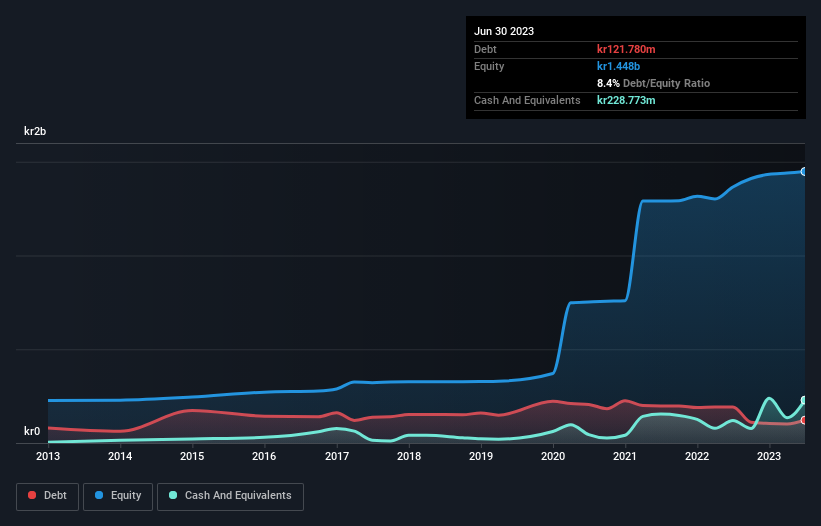
Howard Marks put it nicely when he said that, rather than worrying about share price volatility, 'The possibility of permanent loss is the risk I worry about... and every practical investor I know worries about.' When we think about how risky a company is, we always like to look at its use of debt, since debt overload can lead to ruin. We can see that Train Alliance Sweden AB (publ) (STO:TRAIN B) does use debt in its business. But the more important question is: how much risk is that debt creating?
Why Does Debt Bring Risk?
Generally speaking, debt only becomes a real problem when a company can't easily pay it off, either by raising capital or with its own cash flow. In the worst case scenario, a company can go bankrupt if it cannot pay its creditors. However, a more common (but still painful) scenario is that it has to raise new equity capital at a low price, thus permanently diluting shareholders. Of course, debt can be an important tool in businesses, particularly capital heavy businesses. The first thing to do when considering how much debt a business uses is to look at its cash and debt together.
See our latest analysis for Train Alliance Sweden
How Much Debt Does Train Alliance Sweden Carry?
The image below, which you can click on for greater detail, shows that Train Alliance Sweden had debt of kr121.8m at the end of June 2023, a reduction from kr192.1m over a year. But on the other hand it also has kr228.8m in cash, leading to a kr107.0m net cash position.

A Look At Train Alliance Sweden's Liabilities
We can see from the most recent balance sheet that Train Alliance Sweden had liabilities of kr32.8m falling due within a year, and liabilities of kr111.8m due beyond that. Offsetting this, it had kr228.8m in cash and kr16.7m in receivables that were due within 12 months. So it can boast kr100.9m more liquid assets than total liabilities.
This surplus suggests that Train Alliance Sweden has a conservative balance sheet, and could probably eliminate its debt without much difficulty. Succinctly put, Train Alliance Sweden boasts net cash, so it's fair to say it does not have a heavy debt load! The balance sheet is clearly the area to focus on when you are analysing debt. But it is Train Alliance Sweden's earnings that will influence how the balance sheet holds up in the future. So when considering debt, it's definitely worth looking at the earnings trend. Click here for an interactive snapshot.
Over 12 months, Train Alliance Sweden made a loss at the EBIT level, and saw its revenue drop to kr130m, which is a fall of 47%. To be frank that doesn't bode well.
So How Risky Is Train Alliance Sweden?
While Train Alliance Sweden lost money on an earnings before interest and tax (EBIT) level, it actually booked a paper profit of kr83m. So taking that on face value, and considering the cash, we don't think its very risky in the near term. With mediocre revenue growth in the last year, we're don't find the investment opportunity particularly compelling. The balance sheet is clearly the area to focus on when you are analysing debt. But ultimately, every company can contain risks that exist outside of the balance sheet. To that end, you should be aware of the 2 warning signs we've spotted with Train Alliance Sweden .
Of course, if you're the type of investor who prefers buying stocks without the burden of debt, then don't hesitate to discover our exclusive list of net cash growth stocks, today.
Valuation is complex, but we're here to simplify it.
Discover if Train Alliance might be undervalued or overvalued with our detailed analysis, featuring fair value estimates, potential risks, dividends, insider trades, and its financial condition.
Access Free AnalysisHave feedback on this article? Concerned about the content? Get in touch with us directly. Alternatively, email editorial-team (at) simplywallst.com.
This article by Simply Wall St is general in nature. We provide commentary based on historical data and analyst forecasts only using an unbiased methodology and our articles are not intended to be financial advice. It does not constitute a recommendation to buy or sell any stock, and does not take account of your objectives, or your financial situation. We aim to bring you long-term focused analysis driven by fundamental data. Note that our analysis may not factor in the latest price-sensitive company announcements or qualitative material. Simply Wall St has no position in any stocks mentioned.
About OM:TRAIN B
Train Alliance
Engages in the development of production facilities for railway-related operations in infrastructure and logistics in Sweden.
Flawless balance sheet with acceptable track record.
Market Insights
Community Narratives



